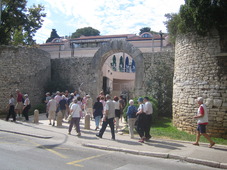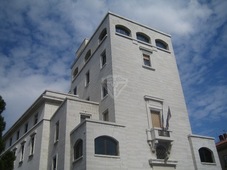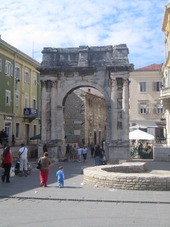to enlarge


or choose the place
from the menu below
 Rome |
 Byzantium |
 Venice |
 Vienna |
 Brioni |
 Smrikve |
 |
 |
 If you turn back towards the twin gates and continue walking along the town walls you
will arrive in front of Hercules’ gate (“Porta Ercole”).
If you turn back towards the twin gates and continue walking along the town walls you
will arrive in front of Hercules’ gate (“Porta Ercole”).
This is the oldest town gate from the middle of the 1st century BC, when Roman Pula was founded.
It is decorated with a relief showing Hercules’ head and club.
It is also worth mentioning that at the time Hercules was the town patron.
Next to the club there is an inscription bearing the names of two Roman officials that in the middle of the 1st century BC were sent from Rome to lead the settlers with the aim of establishing a colony in the bay of Pula: Lucio Cassio Longino and Lucio Calpurchio Pisone or Cesonino.
The first was probably the brother of Caio Crasso and the second was Caesar’s father-in-law.
Today this gate is the entrance to the seat of the Italian Community.
If you look carefully at the town walls you will see that at the certain level the stones are placed differently, appearing like a horizontal line placed on the wall. This point marks the older walls from the newer ones. When the walls were restored this stone-line technique was usually used to highlight the new wall from the old one.
 Opposite to Hercules’ Gates you will
see a white stone Fascist period building made at the beginning of the 20th century.
Opposite to Hercules’ Gates you will
see a white stone Fascist period building made at the beginning of the 20th century.
If you are interested in architecture I am sure that all around you will recognize several buildings with elements from that period.
In front of this monumental white building Pula’s walking area “korzo” starts.
“Korzo” is, especially during the high school years, the town’s meeting place for young people. You will notice that there are a lot of hackberry trees.
Traditionally hackberry trees were used in Istrian villages as a meeting place of the elders to make important decisions for the community.
Another interesting anecdote is that under “korzo”’s hackberry trees many of Pula’s young people have made some of the most important decisions of their lives by falling in love.
I happen to know that my parents also met under these trees.
 If you continue to walk along the town walls through “korzo” you will arrive
in front of the Triumphal Arch of the Sergi, also named the Golden Gate (“Porta Aurea”).
If you continue to walk along the town walls through “korzo” you will arrive
in front of the Triumphal Arch of the Sergi, also named the Golden Gate (“Porta Aurea”).
In reality the Golden Gate was the name of the town gate that was demolished many years ago, but the name still remains.
This Arch was built at the end of the 1st century BC by Salvia Postuma Sergi with her own money.
It is a very rare privately monument built and not linked to the Roman imperial cult.
This monument was built in honour of the three male members of her family that took part in the battle of Actium in 31 BC.
The Triumphal Arch signifying victory was erected not long after this event, probably between 25 BC and 10 BC.